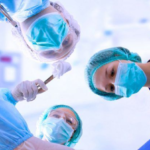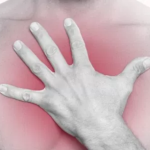Causes and methods of treatment of recurrent inguinal hernia
Recurrence of an inguinal hernia occurs after surgical treatment as a result of a doctor's mistake or due to postoperative complications. Relapse occurs in every 10 patients. Hernia recurrence is an indication for a second operation, but according to a different scheme. If the defect was previously sutured with tissues, re-treatment will be carried out with the installation of a mesh, most likely using the Lichtenstein method.
It is necessary to distinguish between recurrence and ventral hernia. In the first case, the defect appears in the same place, the disease is completely repeated. Ventral or incisional hernia is a protrusion of organs in the area of a surgical scar. Recurrent hernia is not always associated with surgery, it can be caused by factors before and after surgery. The cause of a ventral hernia is only an operation.
An inguinal hernia may reappear repeatedly, after 2-3 operations. A repeatedly recurring defect is one of the most complex forms of the disease, and not every experienced surgeon can cope with it.
Why does a hernia recur?
The causes of the recurrence of an inguinal hernia after surgery are divided into 3 groups:
- Adverse factors before surgery.
- Doctor's mistake during the operation.
- Postoperative complications.
Surgeons believe that the main reasons for this are the wrong choice of surgical technique and insufficient examination of the patient. Operation according to all the rules completely eliminates any risks during and after treatment. But if during the preparation period or during the operation the doctor loses sight of something, this will have consequences.
Surgeon V.D. Fedorov, in his works, expresses the opinion that all the factors for the appearance of a hernia that exist before surgery persist after surgical treatment and can provoke a relapse at any time. And the most significant of all causes, the doctor highlights the congenital weakness of the connective tissue.
Most of the recurrences are observed in the first year after the operation. More often this occurs with large, oblique and sliding hernias. A tendency to re-develop the pathology is observed in 30-45% of those operated on, but only 10% of patients actually face this problem after hernia repair. From this we can conclude that a lot depends on postoperative rehabilitation, measures taken by the doctor and the patient's concern for his health.
Risk factors before surgery
An inguinal hernia may not disturb the patient for a long time, but this does not mean that it does not need to be removed. Treatment of the defect is carried out only surgically, both in congenital and acquired forms of the disease. When the operation is delayed for a long time, this will already be a risk factor for relapse.
Self-treatment at home, refusal of examination and herniotomy end in a serious condition, when the operation is already performed urgently. Under such conditions, there is a higher risk of making a mistake, which will lead to postoperative complications and re-illness.
The elderly are at risk, which is associated with age-related changes, degenerative processes in the groin area. Patients with concomitant diseases of the abdominal cavity and the genitourinary system, which are accompanied by constipation, cough, and increased intra-abdominal pressure, may experience a recurrence of the disease.
Insufficient preparation before hernia repair also plays a role in the occurrence of recurrence. When the sanitation of the body has not been carried out, overlooked infectious foci can cause purulent inflammation, as a result of which a hernia appears.
During the operation
The second group of causes of hernia recurrence is associated with the following factors:
- wrong choice of technique - strengthening only the anterior abdominal wall with recurrent and direct hernia can lead to re-disease due to the high inguinal gap and deep canal, and in order to avoid such a problem, it is necessary to conduct a series of studies, take into account the pathogenetic features of the disease;
- surgeon's mistakes during the operation - suturing with high tissue tension, damage to nerves and blood vessels, insufficient release of hernial contents, and many other actions can provoke a relapse.
The condition for a successful operation will always be high-quality preparation and sanitation. Children and adult patients with an indication for surgical treatment are advised to be examined by several doctors, listen to the opinion of each and trust the opinion of the majority of specialists. The doctor must be aware of past diseases and operations. Some surgical techniques are contraindicated in previous surgical treatment of the gastrointestinal tract and small pelvis.
After operation
Already after the operation, complications can provoke the disease, especially purulent inflammation, bleeding and damage to internal organs.
What complications appear in the early and late period after hernia repair:
- infection of the wound - suppuration occurs when an infection enters during the operation or after it if the rules for caring for the postoperative scar are not followed;
- hematoma - appears as a result of rupture of blood vessels;
- damage to the spermatic cord - occurs during the selection of the hernial sac, the error is typical for an inexperienced surgeon, this complication often occurs already during the removal of a repeated defect and threatens with infertility;
- thrombosis of the veins of the lower leg - occurs in older people and young patients who lead an inactive lifestyle, anticoagulants are used for treatment;
- dropsy - the most common complication, treated only by a second operation;
- damage to the intestine - occurs when careless processing of the hernial sac, the surgeon can also touch the bladder;
- violation of the femoral joint - occurs when the suturing is incorrect, in the case of using a rough material, which can lead to bleeding.
Types of relapses
Distinguish between true and false recurrence. In the first case, the disease completely repeats itself. False recurrence occurs when a defect develops in another area or in a different form. True and false direct hernias in the groin are more common, oblique protrusions are diagnosed in a ratio of 1/5.
Repeated inguinal hernia is of the following types:
- oblique - surrounded by the spermatic cord, completely repeats the course of the inguinal canal;
- direct - medial or suprapubic in the lateral part of the inguinal canal;
- lateral - located near the inguinal ring outside the spermatic cord;
- suprapubic - happens with insufficient strengthening of the inguinal canal;
- intermediate - shaped like a mushroom, located in the inguinal triangle;
- complete - with complete destruction of the inguinal wall, the canal gap is filled with a large hernia.
Inguinal hernia is more often removed by the Lichtenstein method, and the typical forms of recurrence after this operation are lateral and medial recurrences.
Surgery for repeated inguinal hernia
The method of treatment will depend on the degree of complexity:
- First degree - hernia volume up to 100 cm³, Kukudzhanov, Shouldice method.
- Second degree - hernia volume up to 300 cm³, Lichtenstein method.
- Third degree - hernia volume up to 400 cm³, Rivera method.
- Fourth degree - hernia volume from 400 cm³, TEP method, TABP.
The choice of technique is determined by the type of plastic surgery performed earlier, the location of the hernia and its condition. A universal operation will be laparoscopic hernioplasty, it can be performed at any stage of the protrusion, with the exception of a strangulated hernia. Lichtenstein surgery and reconstructive obturation hernioplasty are considered reliable techniques.
The operation is performed in two ways - through open and laparoscopic access. Operation through the postoperative scar is carried out by the classical method according to Liechtenstein, by complete reconstructive hernioplasty or partial obturation plasty. The laparoscopic method involves the creation of access to the hernia by three punctures in the abdominal cavity, through which instruments for hernia repair and a camera for visual control are inserted.
Features of different types of operations for recurrent hernia in the groin:
- Lichtenstein method - with a large size of the hernial sac and repeated recurrence, it is performed with suturing of a mesh implant, the hospitalization period is up to 3 days;
- complete reconstructive hernioplasty - in case of recurrence after plastic surgery with preservation of the structure, during the operation the implant is fixed with sutures to prevent displacement, the hospitalization period is up to 3 days;
- partial hernioplasty - with previously performed plastic surgery of the posterior wall of the inguinal canal, in the case of a small size of the hernia ring, this is the least traumatic method, the patient is discharged from the hospital immediately after the operation;
- laparoscopic method - with bilateral hernia, involves the introduction of an implant through the abdominal cavity to the hernial orifice from the inside, this is a complex version of the operation, it can only be performed under general anesthesia, therefore, open technique is less often prescribed.
Postoperative rehabilitation
Depending on the type of operation, you will need to stay in the hospital from 1 to 5 days. When the doctor sees that everything is in order and there are no complications, he will give recommendations about the care of the scar and lifestyle in the first weeks after treatment.
If there are any problems immediately after the operation, the doctor finds out whether this may be due to surgery or anesthesia. After identifying the cause, the specialist will prescribe additional treatment that will need to be done at home. If a repeated hernia appeared immediately, a second examination is carried out and a second operation is prescribed.
General rules in the early period of rehabilitation after hernia repair:
- daily dressing change and wound treatment with an antiseptic;
- diet, exclusion of any physical work;
- wearing a bandage for several hours while doing daily activities;
- a visit to the doctor in a week for examination and in case of complications.
After the operation, symptoms of complications may appear, with which you need to go to the doctor:
- swelling in the groin area does not go away for several days;
- severe pain and suppuration of the postoperative wound;
- swelling of tissues in the groin with general malaise and fever;
- burning, numbness or increased sensitivity of the skin at the site of surgery.
Normal symptoms after surgery will be mild discomfort while walking, slight burning sensation in the groin, and swelling. The condition improves after a few days, but for another 1-2 months you need to exclude physical activity, and always use a bandage during exercise and exercise.
Diet
Diet is the most important part of postoperative recovery. The diet is prescribed to prevent constipation and bloating, because these disorders lead to an increase in intra-abdominal pressure, and this is a factor in the development of re-hernia.
How to eat the first 2 weeks after hernia repair:
- you need to eat in small portions, chewing everything thoroughly;
- food should be at a comfortable temperature and not spicy;
- it is important to increase the protein content in the diet;
- you need to drink a lot of clean water, but not with meals, but 30 minutes before or after;
- the diet may include boiled white meat, cottage cheese, cereals, fish;
- fixing and gas-forming products are excluded.
Bandage
The support bandage after the operation can be worn not always and not constantly. It is contraindicated in suppuration of the skin and the first few days after hernia repair. When the wound has healed, the doctor will recommend a treatment belt to wear while doing household chores and exercising. The bandage will reduce pressure on the stitches, preventing them from coming apart, and will also help prevent recurrence.
The belt after the operation must be with soft inserts, let air through and absorb moisture. Before putting on the belt, it must be treated with an antiseptic. It is recommended to wear a postoperative bandage no more than 5 hours a day, it must be removed at night.










